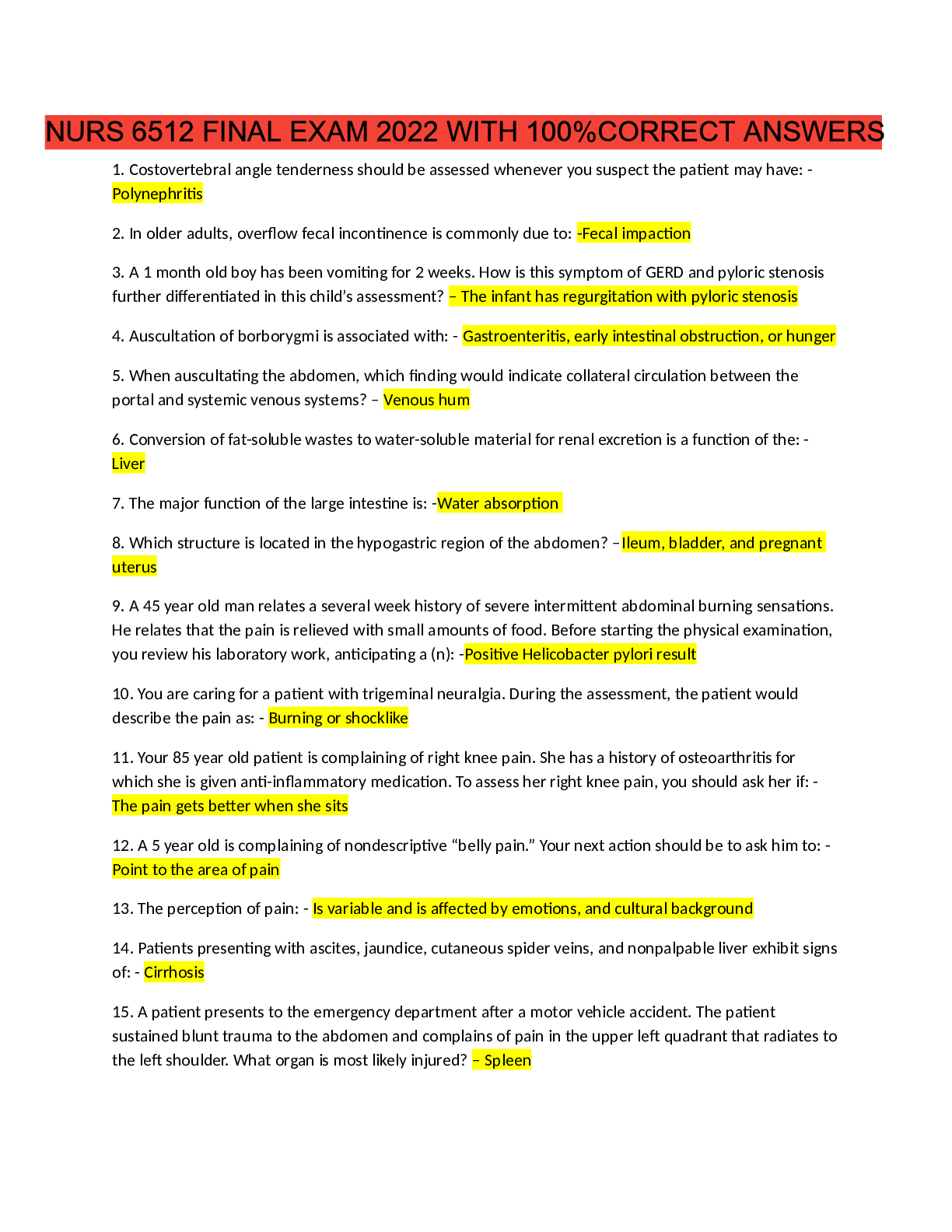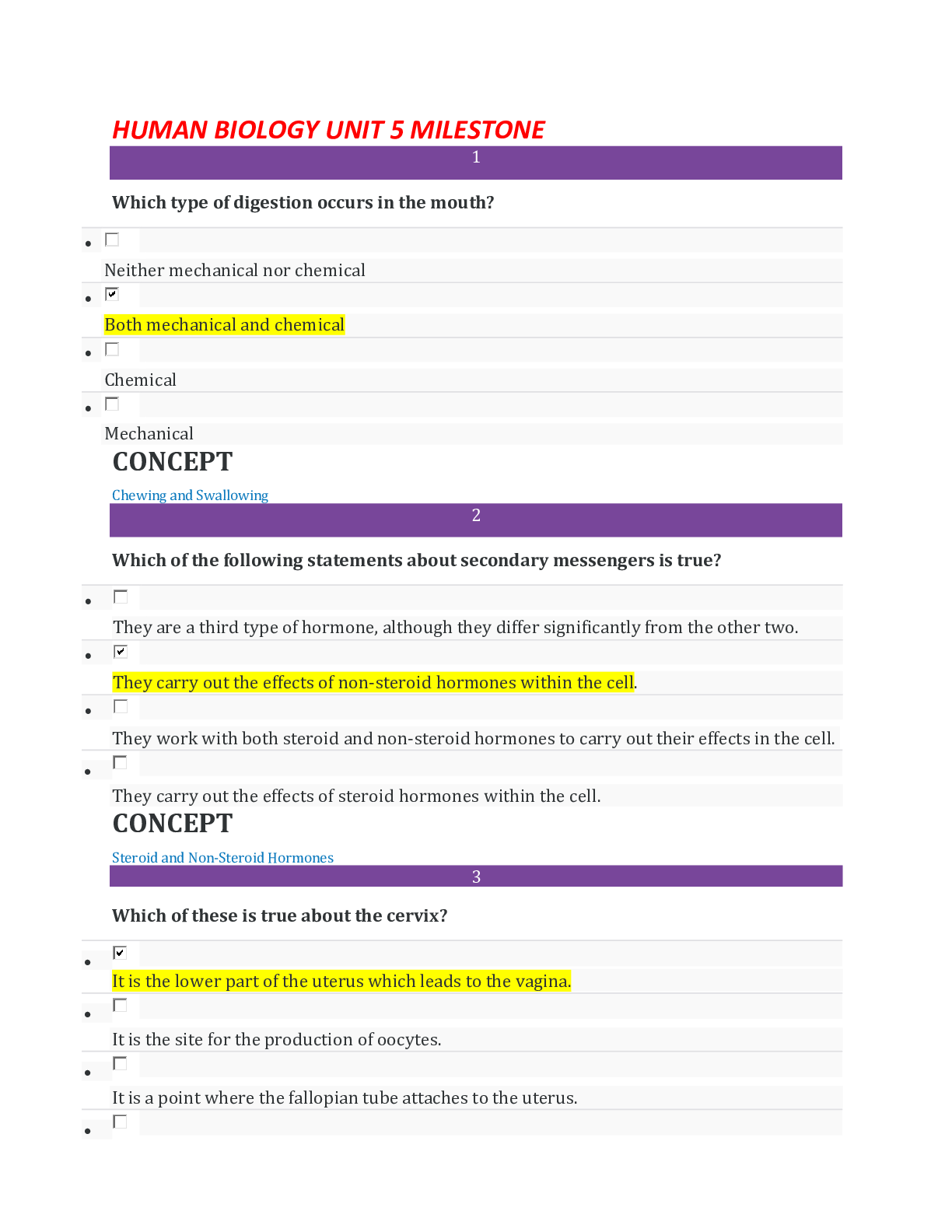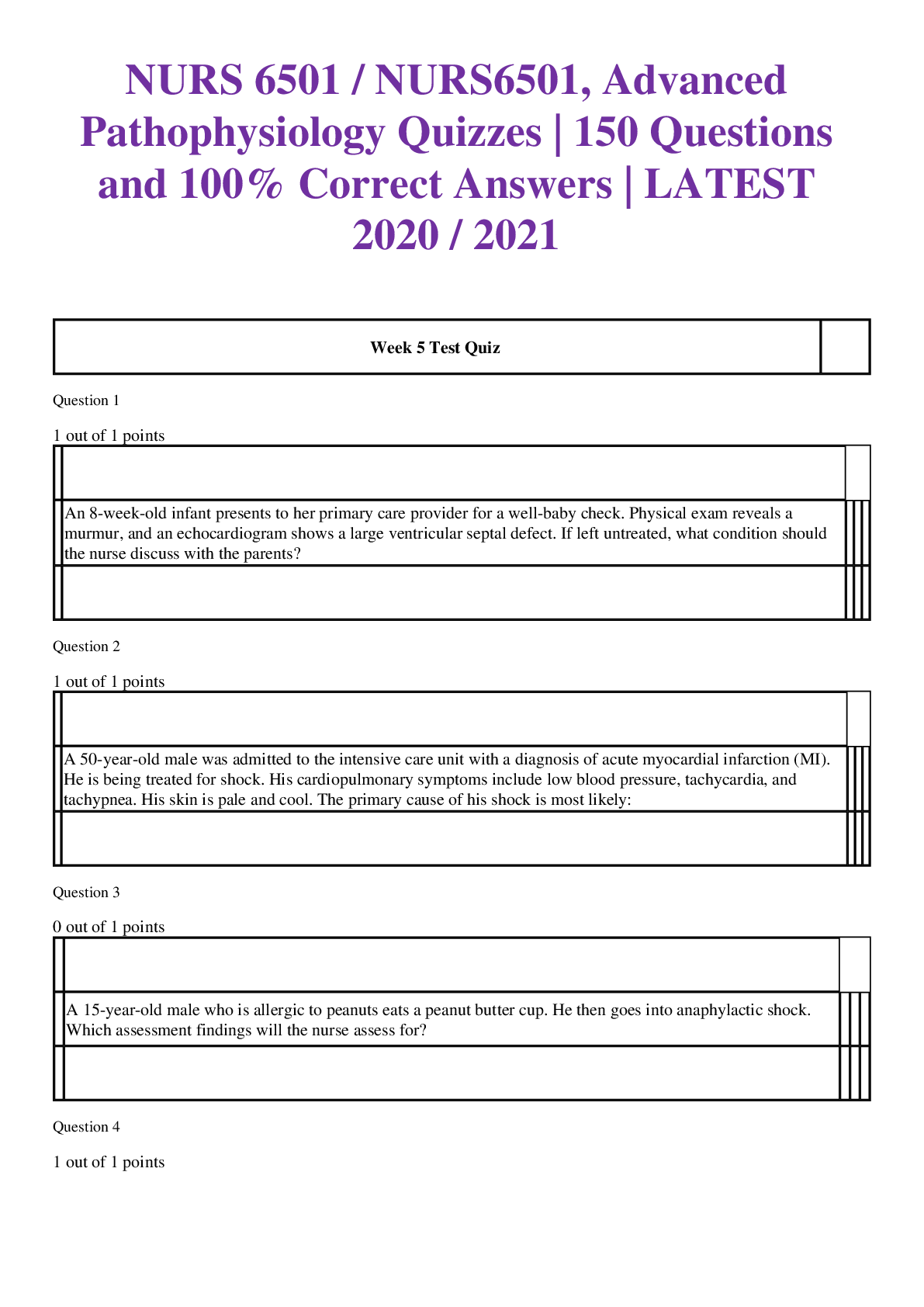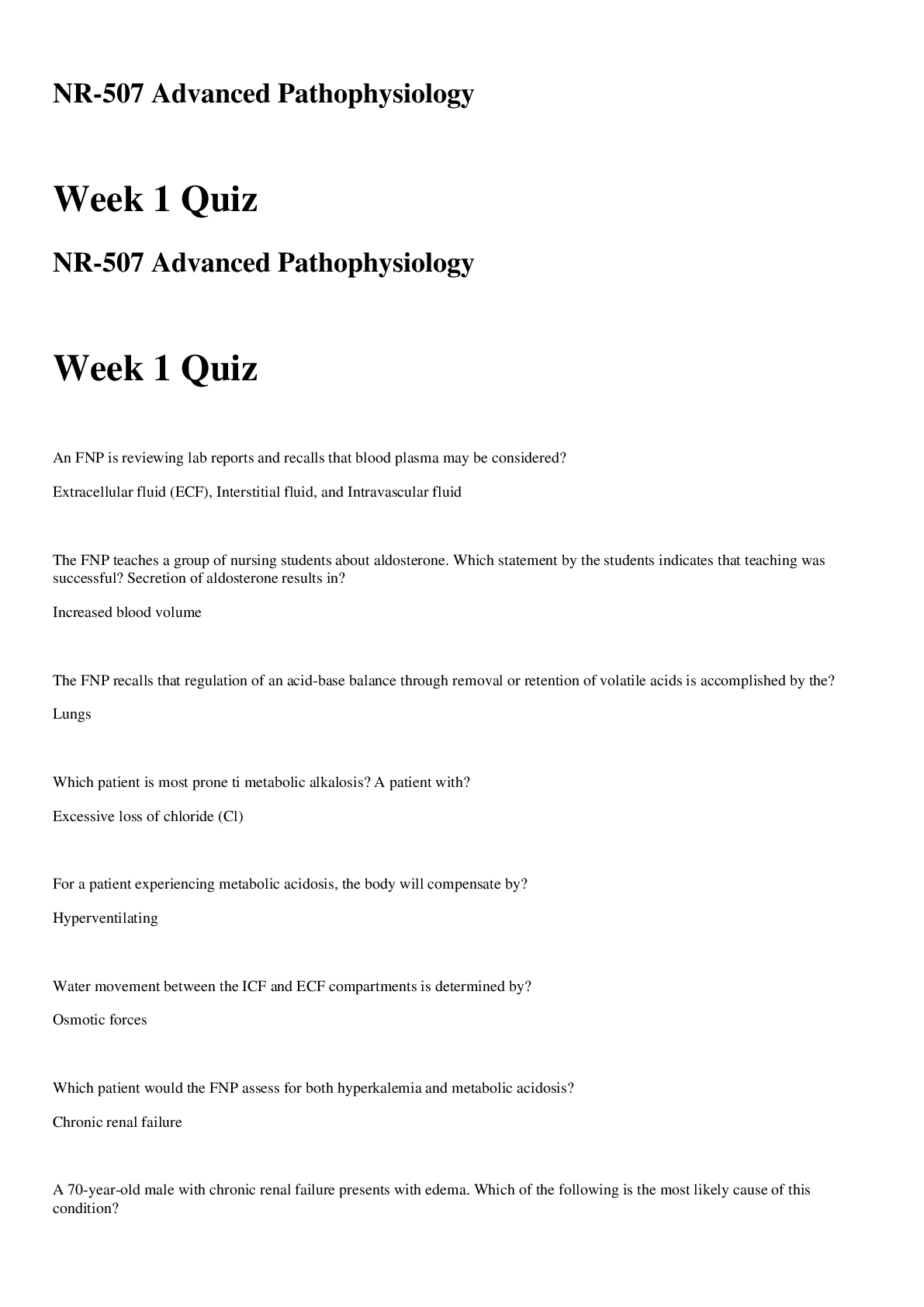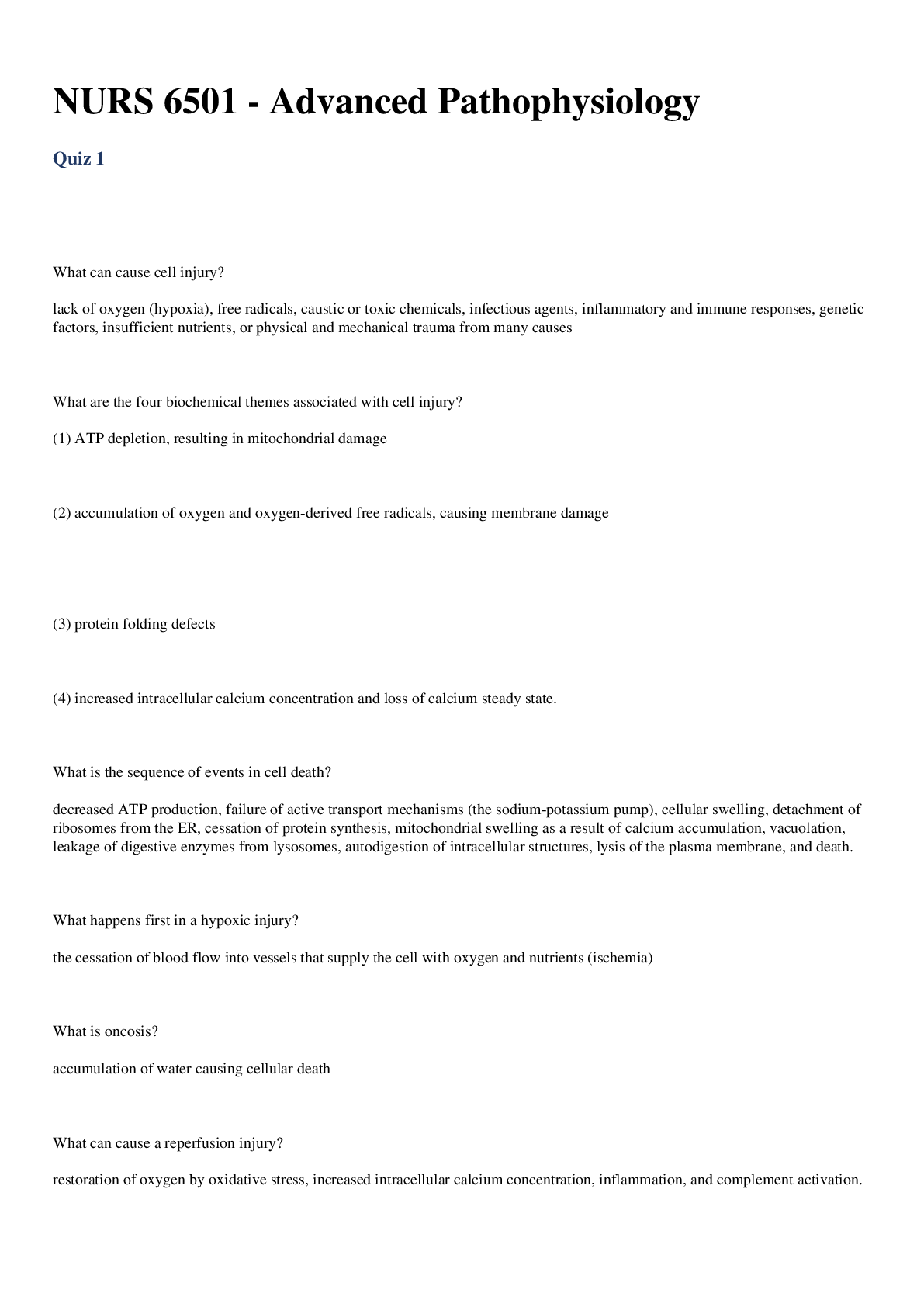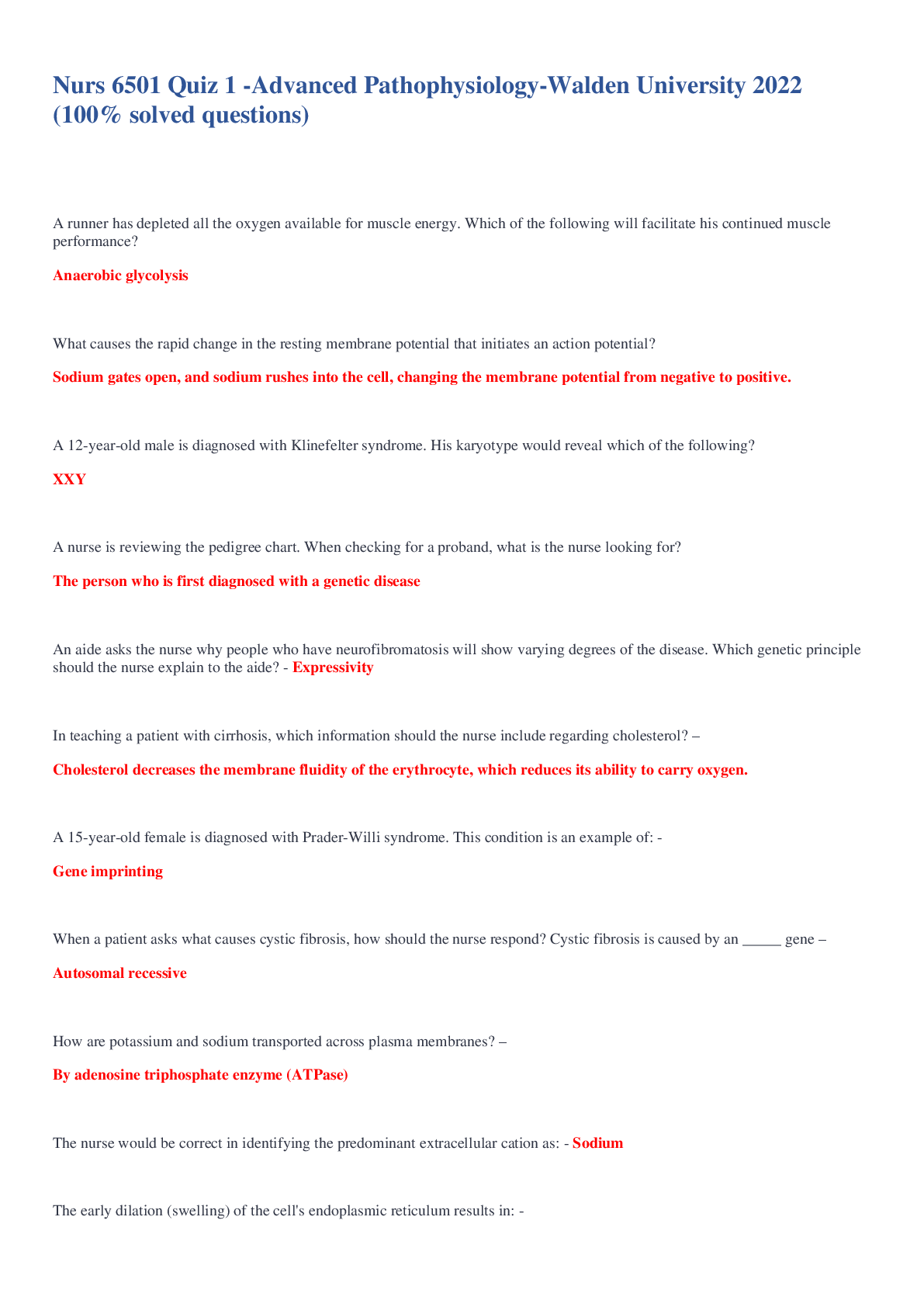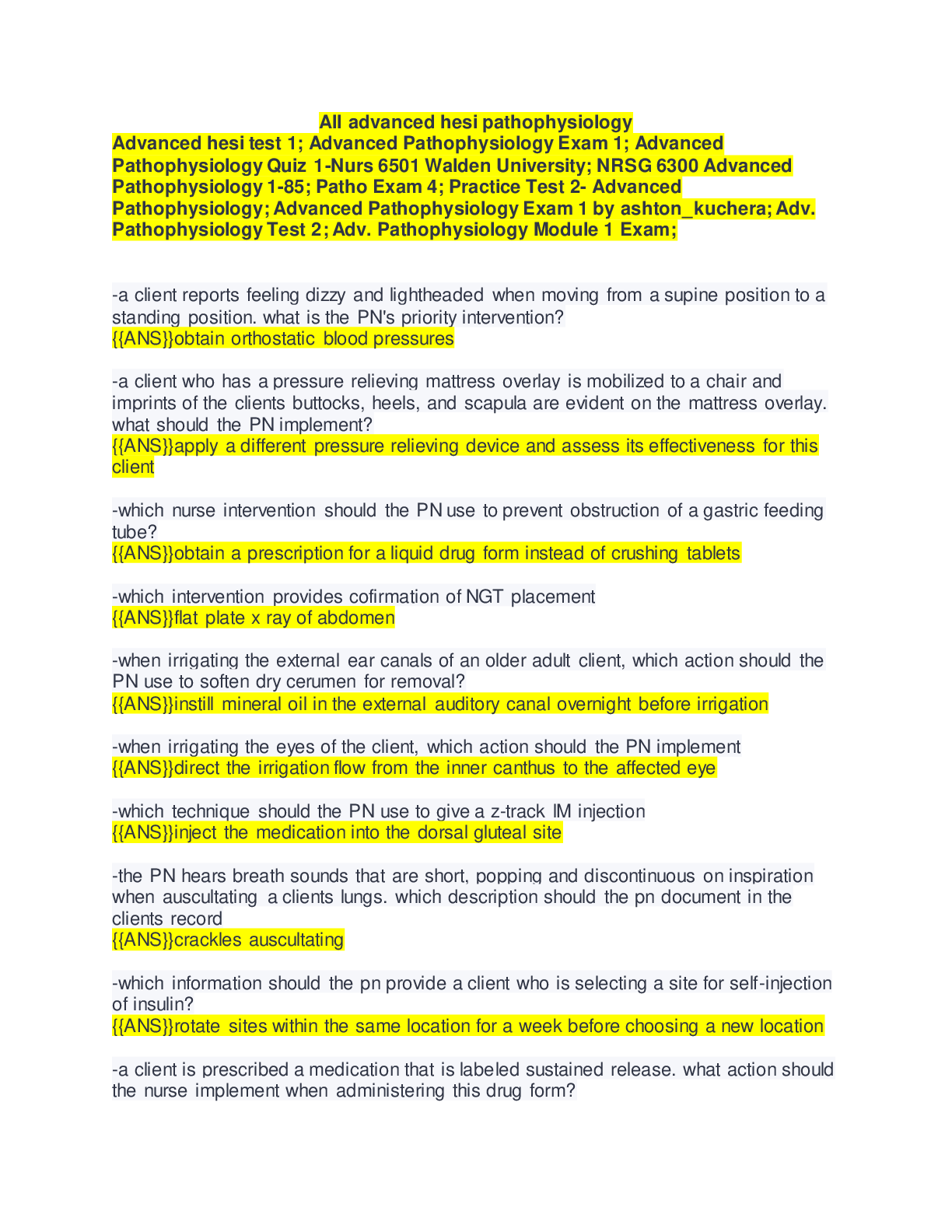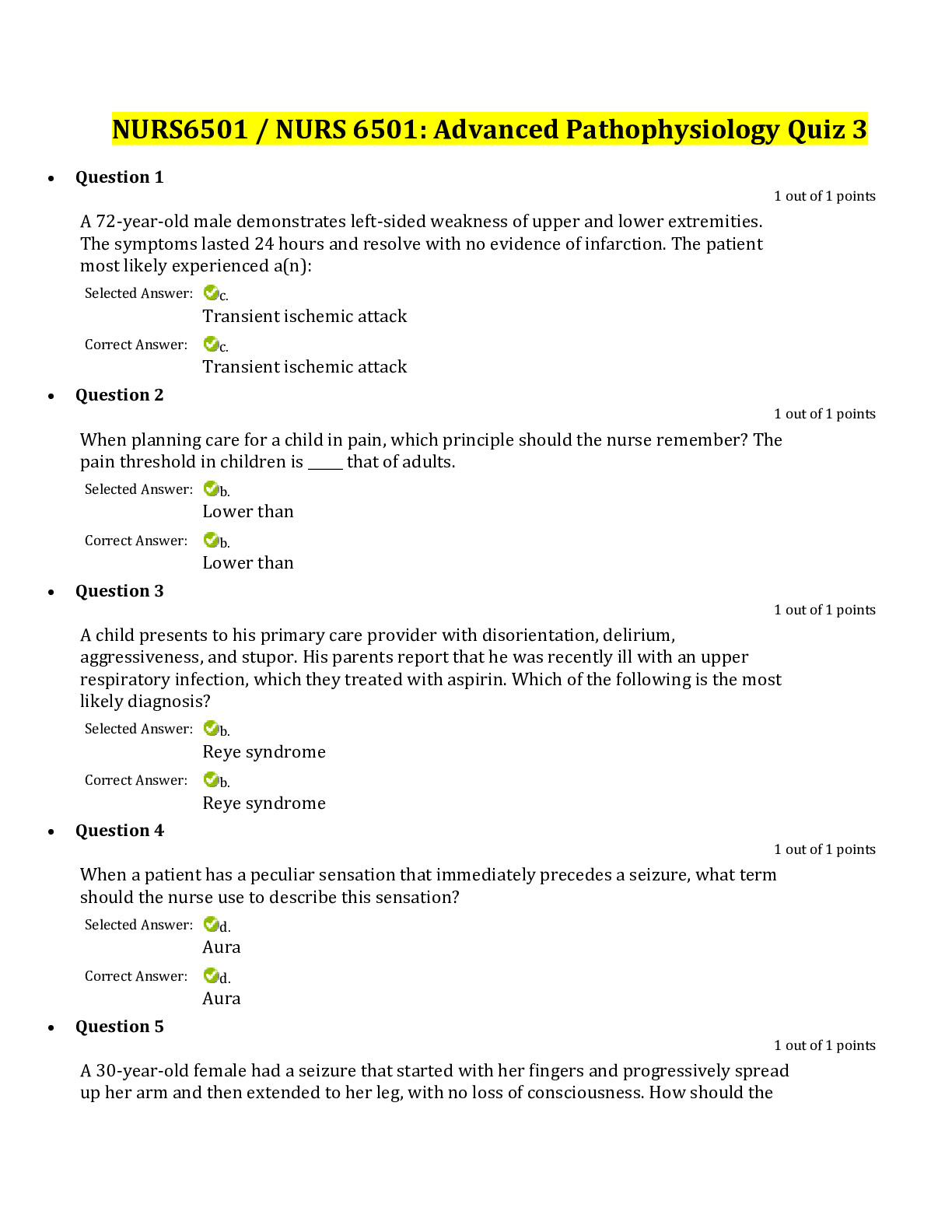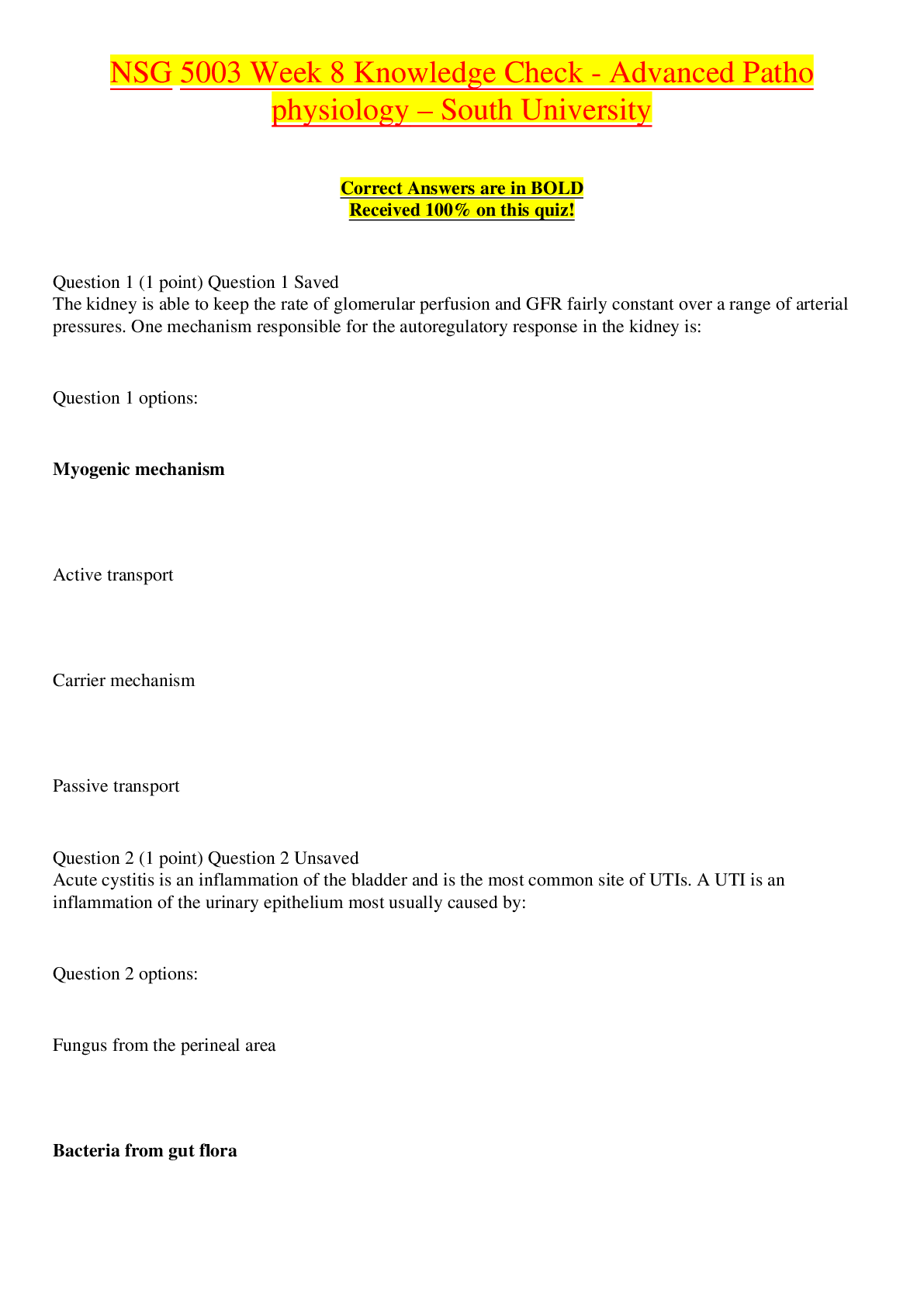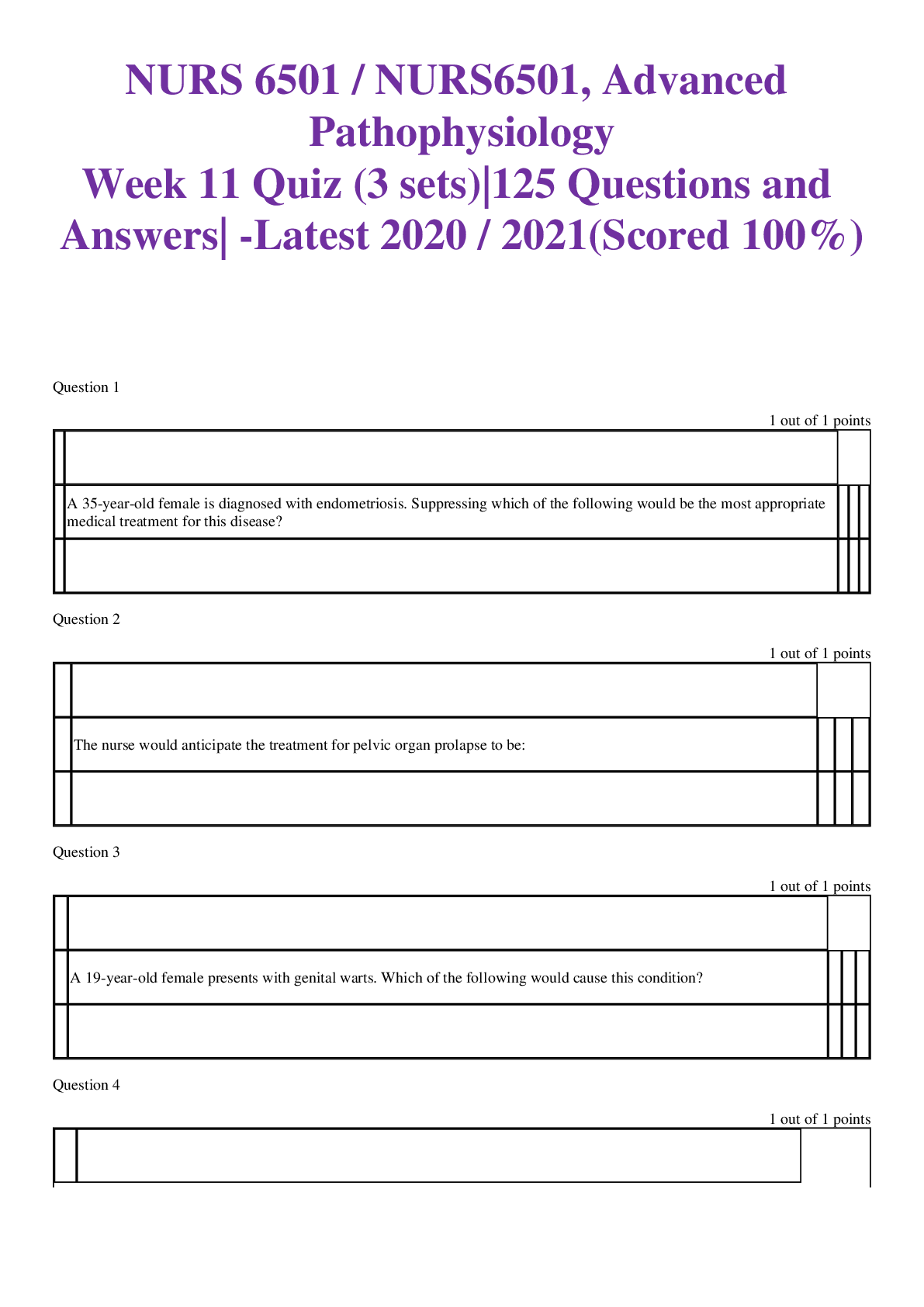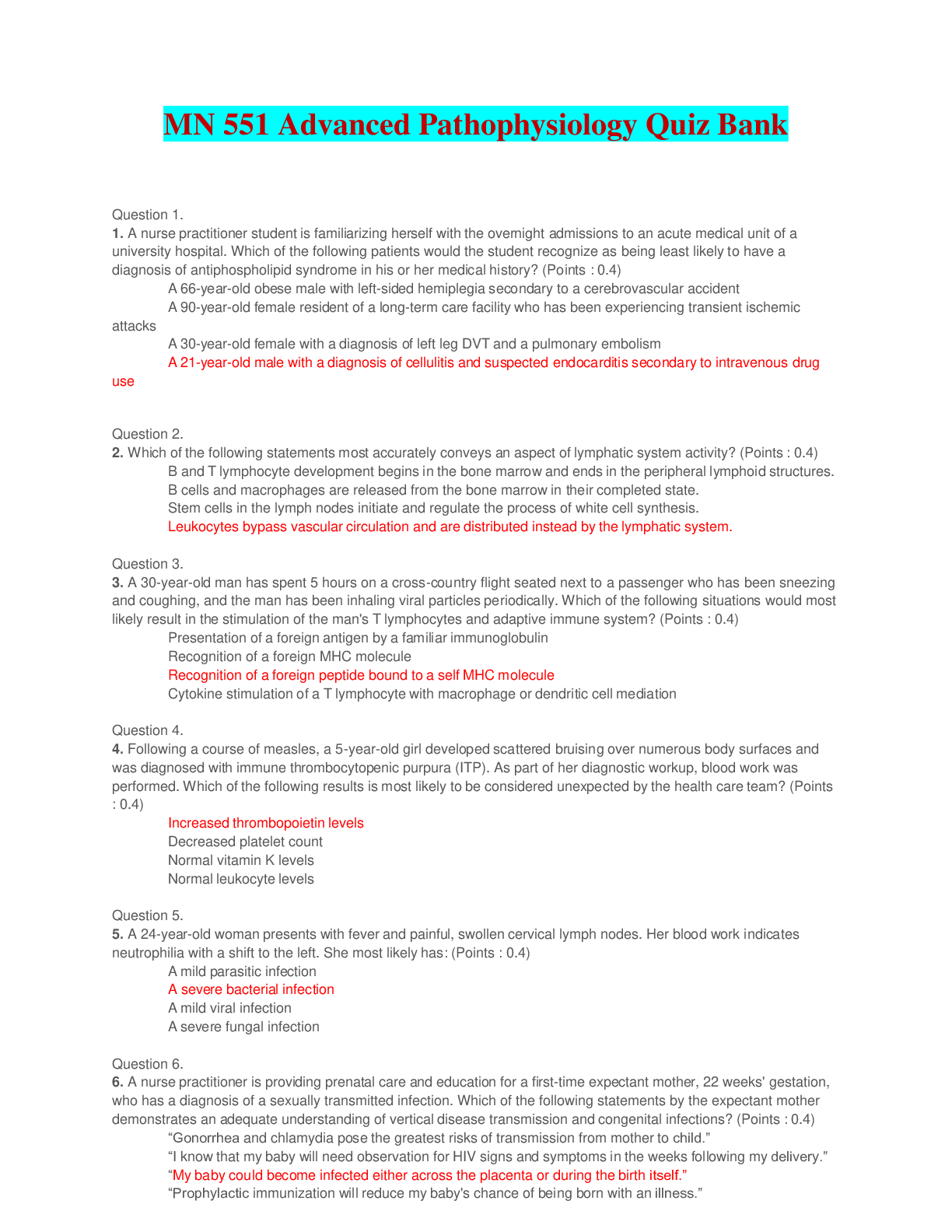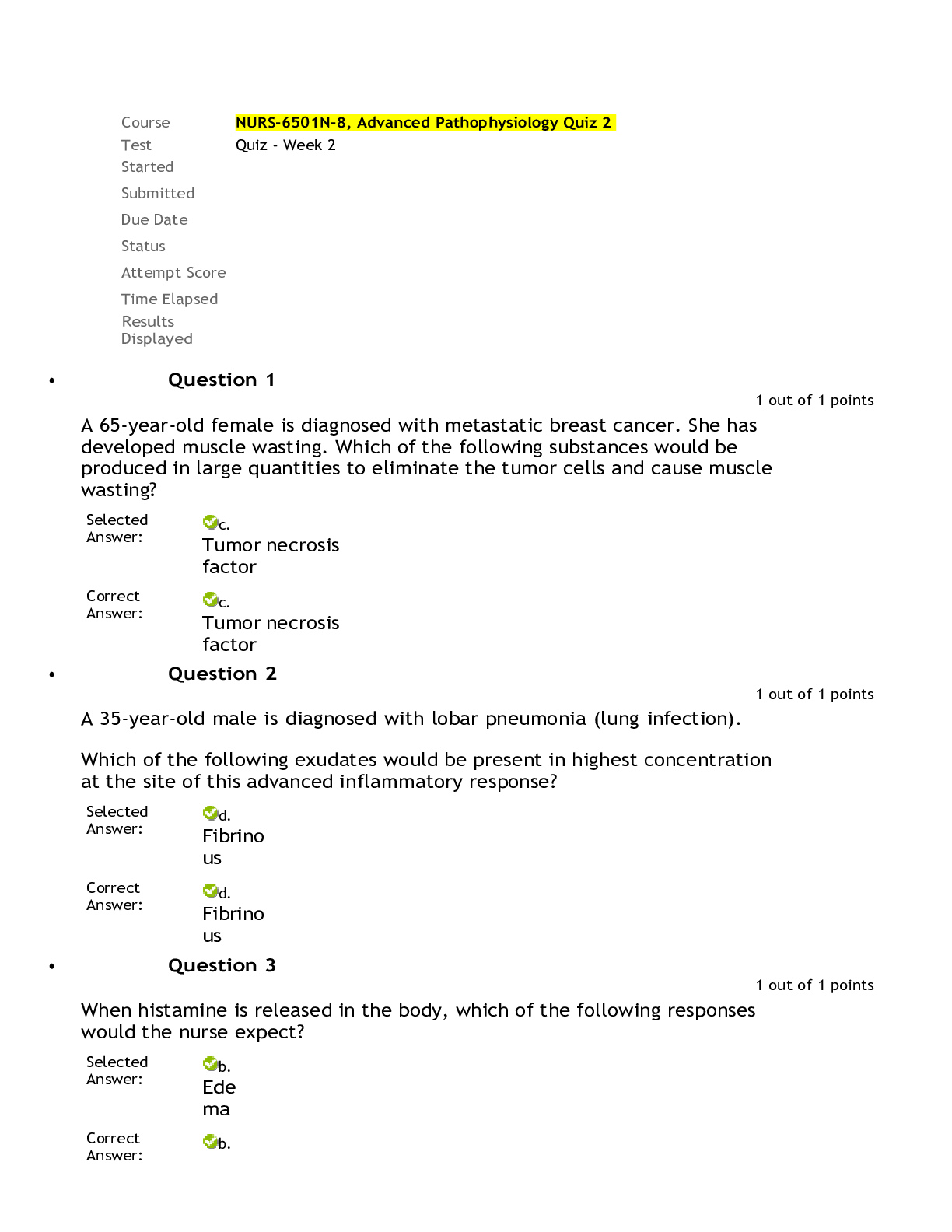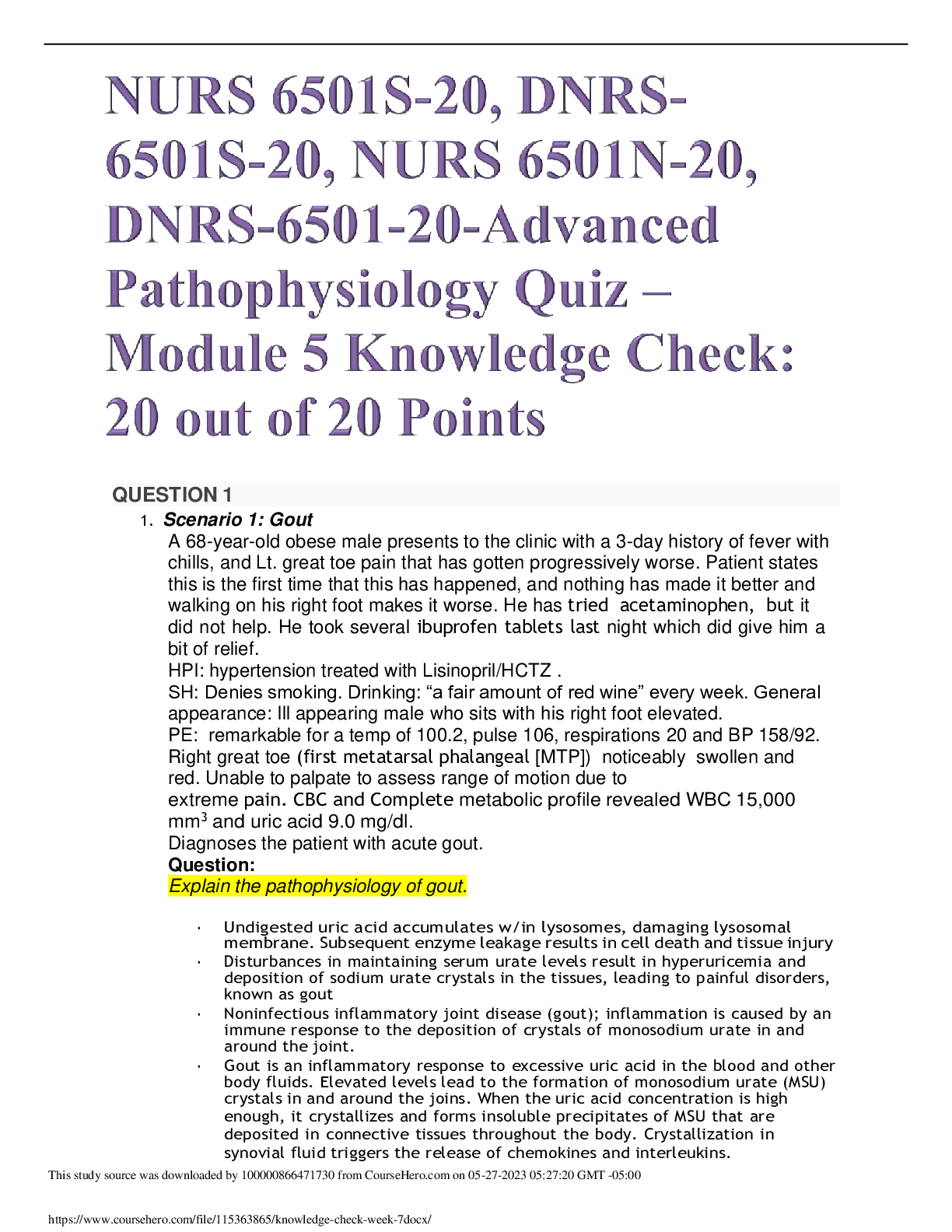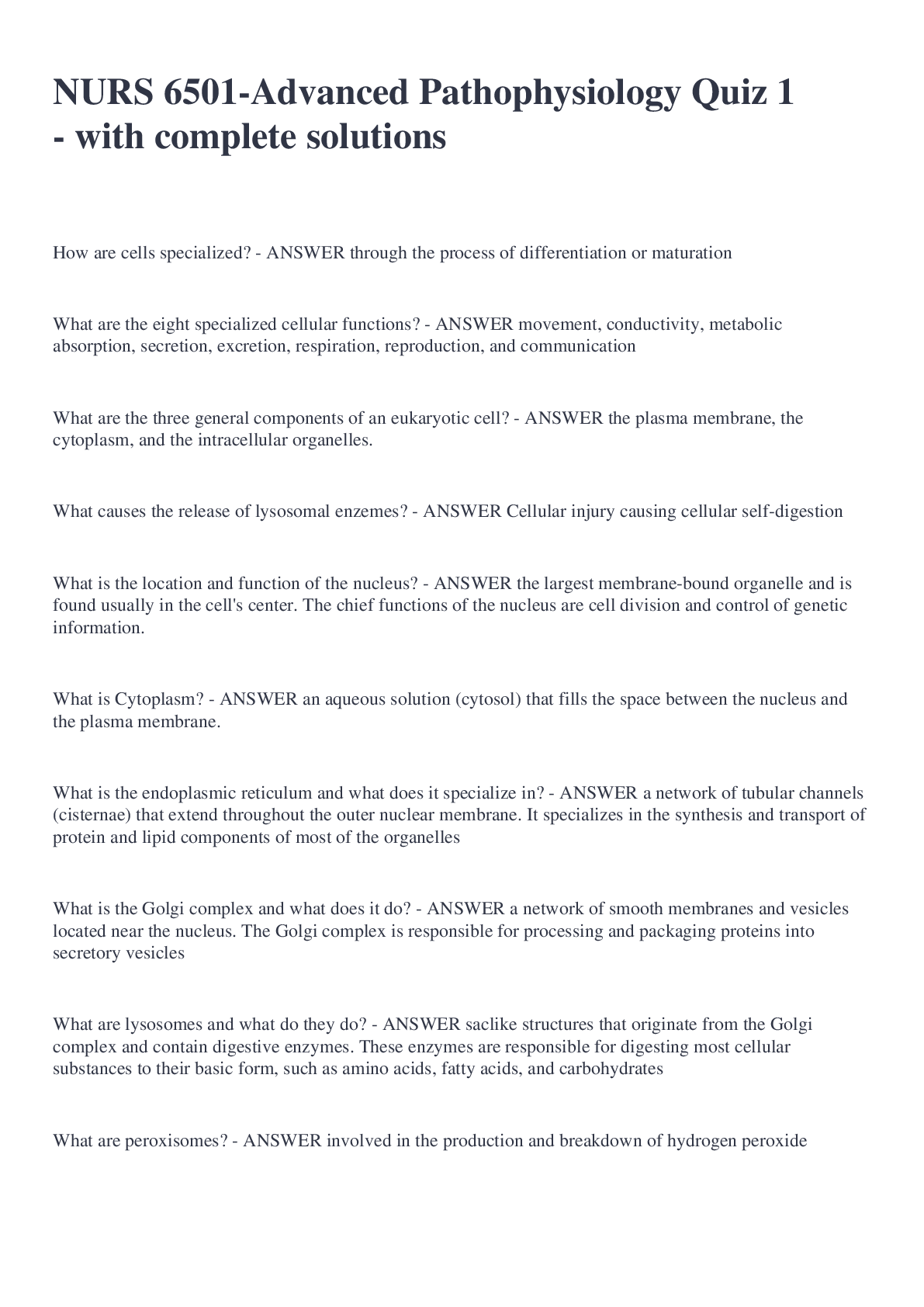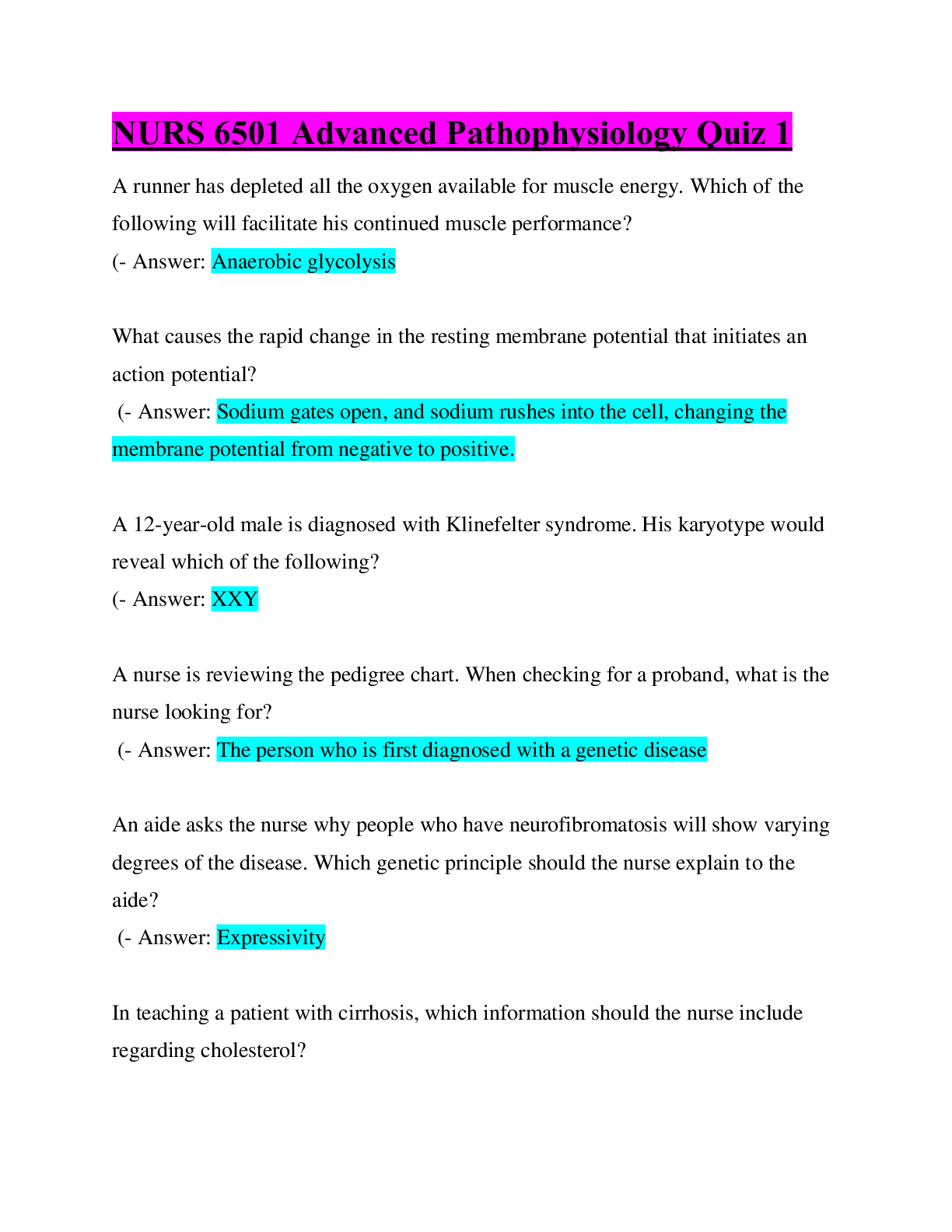NURS 6501N Advanced pathophysiology quiz week 9 Fall 2019,100% CORRECT
Document Content and Description Below
A 25-year-old male presents to his primary care provider reporting changes in facial features. CT scan reveals a mass on the anterior pituitary, and lab tests reveal severely elevated growth hormone (... GH). Which of the following would the nurse also expect to find? Selected Answer: c. Sexual dysfunction • Question 2 1 out of 1 points When a patient wants to know what most commonly causes hypoparathyroidism, how should the nurse reply? It is most commonly caused by: Selected Answer: c. Parathyroid gland injury • Question 3 1 out of 1 points When insulin binds to its receptors on muscle cells, an increase in glucose uptake by the muscle cells occurs. This is an example of a _____ effect by a hormone. Selected Answer: d. Direct • Question 4 1 out of 1 points A 3-year-old male was diagnosed with congenital hypothyroidism. The parents ask the nurse if left untreated what will happen. What is the nurse’s best response? If left untreated, the child would have: Selected Answer: a. Mental retardation and stunted growth • Question 5 1 out of 1 points A nurse is teaching a patient about insulin. Which information should the nurse include? Insulin is primarily regulated by: Selected Answer: b. Serum glucose levels • Question 6 1 out of 1 points A nurse recalls insulin has an effect on which of the following groups of electrolytes? Selected Answer: d. Potassium, magnesium, phosphate • Question 7 1 out of 1 points A 50-year-old male patient is deficient in ADH production. Which of the following assessment findings would the nurse expect to find? Selected Answer: c. ADH is decreased by changes in intravascular volume • Question 8 1 out of 1 points Visual disturbances are a common occurrence in patients with untreated Graves disease. The endocrinologist explains to the patient that the main cause of these complications is: Selected Answer: b. Orbital edema and protrusion of the eyeball • Question 9 1 out of 1 points A 40-year-old male undergoes surgery for a PTH-secreting tumor in which the parathyroid is removed. Which of the following would the nurse expect following surgery? Selected Answer: c. Decreased calcium reabsorption in the kidney • Question 10 1 out of 1 points An aide asks the nurse what is the most common cause of elevated levels of antidiuretic hormone (ADH) secretion. How should the nurse respond? Selected Answer: b. Cancer • Question 11 1 out of 1 points A 35-year-old female took corticosteroid therapy for several months. Which of the following would the nurse expect to find? Selected Answer: d. Type 2 DM • Question 12 1 out of 1 points A 22-year-old male is admitted to the intensive care unit with a closed head injury sustained in a motorcycle accident. The injury has caused severe damage to the posterior pituitary. Which of the following complications should the nurse anticipate? Selected Answer: b. Dehydration from polyuria • Question 13 1 out of 1 points While planning care for a patient with hypothyroidism, which principle should the nurse remember? The basal metabolic rate is unusually _____ with hypothyroidism. Selected Answer: b. Low • Question 14 1 out of 1 points A 44-year-old patient with pulmonary tuberculosis (lung infection) is evaluated for SIADH. Which of the following assessment findings would be expected in this patient? Selected Answer: d. Concentrated urine • Question 15 1 out of 1 points A 30-year-old male was diagnosed with hypothyroidism. Synthesis of which of the following would decrease in this patient? Selected Answer: a. TSH and TH • Question 16 1 out of 1 points A patient has researched lipid-soluble hormones on the Internet. Which information indicates the patient has a good understanding? Lipid-soluble hormone receptors cross the plasma membrane by: Selected Answer: a. Diffusion • Question 17 1 out of 1 points A 25-year-old male presents with fatigue, constipation, and sexual dysfunction. Tests reveal all pituitary hormones are normal and no masses are present. The nurse suspects the most likely cause of his symptoms is a dysfunction in the: Selected Answer: d. Pituitary stalk • Question 18 1 out of 1 points If the patient has a problem with the pineal gland, which substance would the nurse monitor? Selected Answer: a. Melatonin • Question 19 1 out of 1 points A 54-year-old patient with pulmonary tuberculosis (lung infection) is evaluated for syndrome of inappropriate ADH secretion (SIADH). Which of the following electrolyte imbalances would be expected in this patient? Selected Answer: a. Hyponatremia • Question 20 1 out of 1 points A 19-year-old female with type 1 DM was admitted to the hospital with the following lab values: serum glucose 500 mg/dl (high), urine glucose and ketones 4+ (high), and arterial pH 7.20 (low). Her parents state that she has been sick with the “flu” for a week. Which of the following statements best explains her acidotic state? Selected Answer: d. Insulin deficiency promotes lipid metabolism and ketone formation. • Question 21 1 out of 1 points If a patient had a problem with the hypothalamus, which of the following hormones would be affected? Selected Answer: c. ACTH • Question 22 1 out of 1 points Diabetes insipidus, diabetes mellitus (DM), and SIADH share which of the following assessment manifestations? Selected Answer: d. Thirst • Question 23 1 out of 1 points When a nurse is assessing the physical features of individuals with Cushing syndrome, these findings will include: Selected Answer: b. Truncal obesity and moon face • Question 24 1 out of 1 points A 12-year-old male is newly diagnosed with type 1 DM. Which of the following tests should the nurse prepare the patient to best confirm the diagnosis? Selected Answer: a. Fasting plasma glucose levels • Question 25 1 out of 1 points A 30-year-old male presents to his primary care provider reporting visual disturbances. CT reveals a pituitary tumor and lab tests reveal elevated prolactin. He is diagnosed with prolactinoma. Which of the following treatments would the nurse help implement? Selected Answer: a. Dopaminergic agonists • Question 26 1 out of 1 points A patient wants to know why ADH is important in the body. What is the nurse’s best response? ADH is important in: Selected Answer: a. The body’s water balance and urine concentration • Question 27 1 out of 1 points When catecholamines are released in a patient, what should the nurse assess for? Selected Answer: d. Hyperglycemia • Question 28 1 out of 1 points A 35-year-old female with Graves disease is admitted to a medical-surgical unit. While the nurse is reviewing the lab tests, which results would the nurse expect to find? Selected Answer: a. High levels of circulating thyroid-stimulating antibodies • Question 29 1 out of 1 points Which principle should the nurse include while planning care for a patient with an ADH problem? ADH release from the posterior pituitary is stimulated by: Selected Answer: b. High serum osmolarity sensed by osmoreceptors in the hypothalamus • Question 30 1 out of 1 points A 50-year-old female presents with lightheadedness and overall abnormal feelings. Hyperaldosteronism is diagnosed. Which of the following symptoms would the nurse expect? Selected Answer: c. Hypokalemia • Question 31 1 out of 1 points A patient wants to know what can cause ACTH to be released. How should the nurse respond? Selected Answer: d. Acute stressors • Question 32 1 out of 1 points What common neurologic disturbances should the nurse assess for in a patient with a pituitary adenoma? Selected Answer: b. Visual disturbances • Question 33 1 out of 1 points A 45-year-old female has elevated thyroxine production. Which of the following would accompany this condition? Selected Answer: d. Decreased thyroid-stimulating hormone (TSH) • Question 34 1 out of 1 points An endocrinologist isolated a new hormone and found it to be a water-soluble amine. Which of the following is most like this new hormone? Selected Answer: d. Epinephrine • Question 35 1 out of 1 points A 15-year-old female presents with breast discharge, dysmenorrhea, and excessive excitability. Tests reveal that all her pituitary hormones are elevated. What does the nurse suspect as the most likely cause for these assessment findings? Selected Answer: a. A pituitary adenoma [Show More]
Last updated: 1 year ago
Preview 1 out of 9 pages
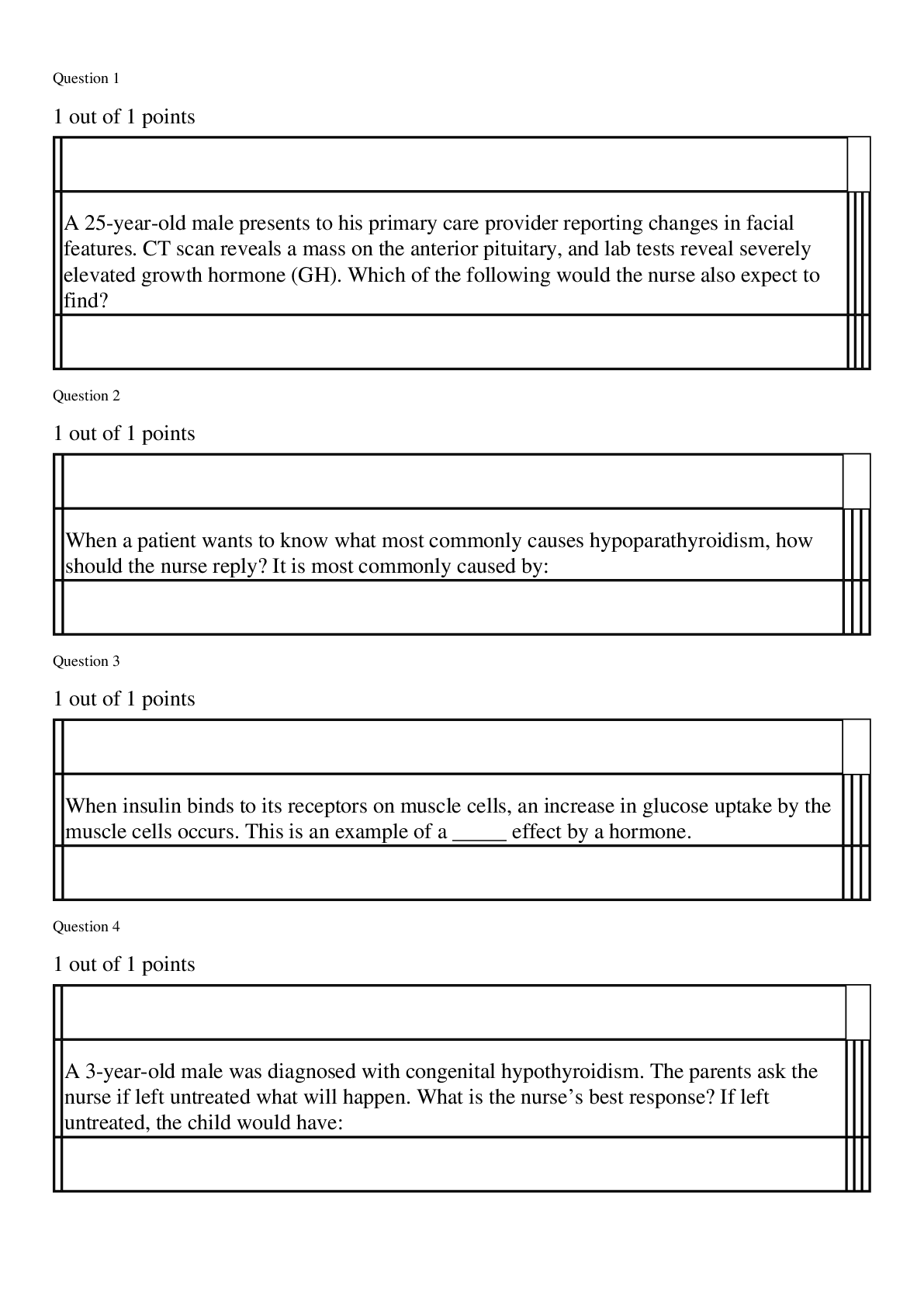
Reviews( 0 )
Document information
Connected school, study & course
About the document
Uploaded On
Feb 18, 2021
Number of pages
9
Written in
Additional information
This document has been written for:
Uploaded
Feb 18, 2021
Downloads
0
Views
37




